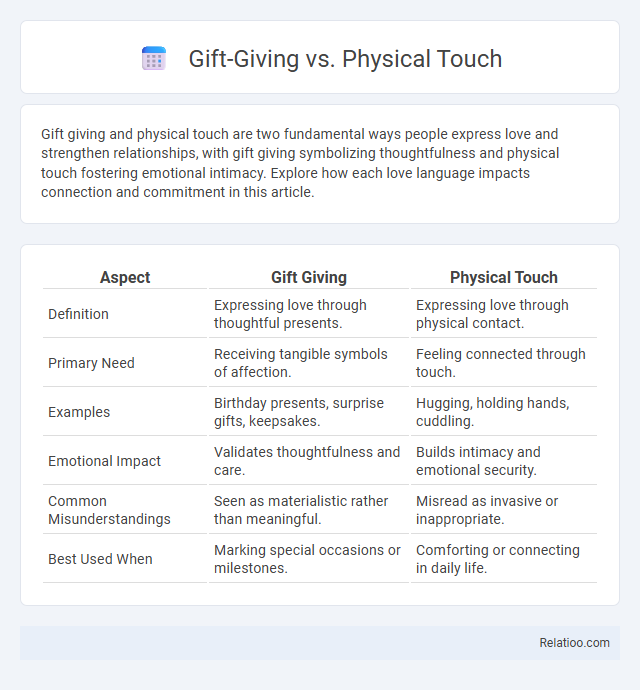Gift giving and physical touch are two fundamental ways people express love and strengthen relationships, with gift giving symbolizing thoughtfulness and physical touch fostering emotional intimacy. Explore how each love language impacts connection and commitment in this article.
Table of Comparison
| Aspect | Gift Giving | Physical Touch |
|---|---|---|
| Definition | Expressing love through thoughtful presents. | Expressing love through physical contact. |
| Primary Need | Receiving tangible symbols of affection. | Feeling connected through touch. |
| Examples | Birthday presents, surprise gifts, keepsakes. | Hugging, holding hands, cuddling. |
| Emotional Impact | Validates thoughtfulness and care. | Builds intimacy and emotional security. |
| Common Misunderstandings | Seen as materialistic rather than meaningful. | Misread as invasive or inappropriate. |
| Best Used When | Marking special occasions or milestones. | Comforting or connecting in daily life. |
Understanding the Five Love Languages
Understanding the Five Love Languages reveals that gift giving, physical touch, and words of affirmation express affection differently based on individual preferences. People who value gift giving see tangible symbols as meaningful tokens of love, while those favoring physical touch prioritize closeness and affection through hugs, hand-holding, or gentle touches. Recognizing these distinct love languages enhances emotional connections and strengthens relationships by honoring each person's unique way of feeling appreciated.
Defining Gift Giving as a Love Language
Gift giving as a love language involves expressing affection and appreciation through thoughtful presents that symbolize care and attention. It emphasizes the value of tangible tokens to communicate emotions, often reflecting the giver's understanding of the recipient's desires and preferences. Unlike physical touch, which conveys love through direct, intimate contact, gift giving creates a lasting, visible reminder of love and commitment.
Exploring Physical Touch as a Love Language
Physical touch as a love language communicates affection, comfort, and emotional connection through gestures like hugs, hand-holding, or gentle touches, often creating a deeper sense of intimacy than material gifts. Unlike gift giving, which expresses love through tangible items, physical touch directly engages your senses and fosters trust and security in relationships. Understanding your partner's preference for physical touch can enhance emotional bonding and improve overall relationship satisfaction.
Psychological Impact of Gift Giving
Gift giving fosters emotional connections by triggering dopamine release, enhancing feelings of happiness and social bonding. Unlike physical touch, which directly stimulates oxytocin, presenting a thoughtful gift activates cognitive appreciation and gratitude in your brain. This psychological impact strengthens relationships through meaningful gestures that convey care and thoughtfulness beyond physical interaction.
Emotional Benefits of Physical Touch
Physical touch triggers the release of oxytocin, dopamine, and serotonin, essential neurochemicals that enhance mood and strengthen emotional bonds. Unlike gift giving, which provides temporary joy through material exchange, physical touch fosters deep emotional security and reduces stress by activating the parasympathetic nervous system. This direct sensory connection promotes empathy, trust, and overall psychological well-being, making it a vital component of healthy relationships.
Cultural Influences on Expressing Love
Cultural influences significantly shape how individuals express love through gift giving, physical touch, or a combination of both. In collectivist societies, gift giving often serves as a primary expression of affection, symbolizing respect and social bonds, while physical touch may be more reserved and context-dependent. Conversely, individualistic cultures tend to prioritize physical touch and verbal affirmations as direct and personal love expressions, with gifts playing a supplementary role.
Challenges in Gift Giving Relationships
Gift giving in relationships often faces challenges such as misinterpretation of the gift's meaning, mismatched expectations regarding value or sentiment, and the pressure to select the "perfect" present. Unlike physical touch, which conveys immediate emotional connection, gifts rely on your understanding of the recipient's preferences and emotional triggers, making errors more likely. Navigating these complexities requires sensitivity to avoid misunderstandings that can strain your bond.
Navigating Boundaries with Physical Touch
Navigating boundaries with physical touch requires clear communication and respect for personal space, as comfort levels vary widely across individuals and cultures. Establishing consent beforehand and being attentive to nonverbal cues helps maintain trust and prevents discomfort in relationships. Balancing physical touch with alternative expressions of affection, such as gift giving, ensures emotional connections are honored without overstepping personal limits.
Finding Balance Between the Two Love Languages
Balancing gift giving and physical touch as love languages involves understanding individual preferences and expressing affection in diverse ways. Combining thoughtful presents with meaningful physical gestures, such as hugs or hand-holding, strengthens emotional connections and fosters intimacy. Prioritizing both tangible tokens and closeness ensures a well-rounded approach to showing love and appreciation.
Tips for Communicating Love Preferences
Understanding your love language, whether Gift Giving, Physical Touch, or Acts of Service, is essential for effective communication in relationships. Clearly expressing your preferences helps avoid misunderstandings and fosters emotional connection by aligning actions with your needs. You can improve intimacy by openly discussing boundaries, favorite gestures, and the significance behind gifts or touch.

Infographic: Gift Giving vs Physical Touch
 relatioo.com
relatioo.com